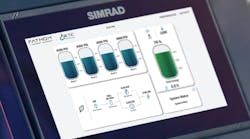Overhaul is one of the most popular uses for a thermal imager (TI). Some fire departments are still learning the potential of TIs, and therefore may limit the use of the technology to overhaul. This series of thermal imaging training columns should have shown you that thermal imaging applications go well beyond overhaul, touching every aspect of firefighting. Leading fire departments are using TIs during every stage of fire suppression, including the overhaul phase.
Essentials
The most important tip to remember during overhaul is that the TI displays scenes on a relative basis. This means that an object that is “hot” on the display (normally shown as white) is hot in comparison to the other items in the scene. This can make image interpretation confusing during overhaul, especially after knockdown and when firefighters are looking for hotspots. To make your TI more effective in overhaul, consider the following:
- Thermal imagers show temperature differences. After knockdown, if the entire scene is white and light gray on the display, spray some water to create temperature differences. This gives the TI other reference temperatures, and as a result enables it to generate more useful images.
- If your TI has a manual iris control (sometimes called a “Thermal Throttle”), learn how to use it. This control restricts the amount of heat reaching the TI detector. As a result, only the hottest items remain white on the display, and all others fade to gray.
- If your TI has a temperature indicator, ensure you understand its uses and limitations. By comparing the temperatures of various surfaces, you may be able to identify sections of wall that deserve additional attention during overhaul.
- Microbolometer TIs frequently have an “EI Mode,” which indicates that the detector has changed sensitivity levels. Most detectors change sensitivity levels when something that is 300ºF or hotter is in the image. Even TI models without an EI indicator on the display screen will have a momentary freeze of the image (when the shutter “fires”) and change sensitivities. Look for the shutter as a potential indicator that a significant hotspot remains in the scene.
- A “hotspot” does not always mean “open up.” Thermal imagers are very sensitive. An area may be relatively hot, but not absolutely hot. That means it could show as white on the display, even though the area is not a hotspot that deserves further examination by firefighters.
- When in doubt, use traditional techniques to determine if a hotspot really needs to be opened up. Feel the area for heat by using your hand. Or, use the TI and compare it to something with a known temperature. Perhaps the easiest comparison point is a partner’s hand. If the spot in question is roughly the same color as the hand, then it is probably not a hotspot that needs attention during overhaul.
Practice Makes Perfect
The best way to get comfortable using the TI during overhaul is to use it after knockdown at every fire. Yes, every fire…car fires, trash fires and structure fires. While firefighters do not “overhaul” vehicle or trash fires in the traditional sense of the word, using the TI can be a learning experience. These incidents give firefighters the opportunity to see how the effects of fire change the heat signatures of objects and alter their appearance on a TI. These incidents also give firefighters practice in using the various indicators and tools on the TI to help them identify hotspots that require additional overhaul.
Additionally, use these fire incidents to practice using the manual iris control, or watch for a change in sensitivity levels indicated by the shutter fire and EI mode indicator. Look for changes in the display and changes in which areas are portrayed as “hotspots” on the display. Watch with the TI as another firefighter sprays down an area with water, and see how the picture on the TI display improves.
Table Talk
The firehouse kitchen can also be a good place to practice image interpretation during overhaul. While you are brewing coffee, place cups of warm and hot water near the coffee maker. Examine how the different objects appear and, more importantly, how the indicators and tools of your TI help you identify which objects are hotter.
Similar practice scenarios can be set up using the stove or oven, especially while preparing meals. Examine burners or pans to see how they are displayed differently as they heat and cool. Again, practice using the additional tools and indicators on your TI to determine which objects are hottest.
Final Report
The ability to use a TI effectively in overhaul requires practice. You cannot expect to use your thermal imager two or three times per month and become proficient at analyzing overhaul scenes. Be sure you are using your TI as frequently as possible to understand how the subtleties of the images can change your course of action. Also, do not forget the traditional overhaul investigative techniques that can help you confirm your image interpretations.
For more ideas on successfully using TIs during overhaul, visit the Technology section of Firehouse.com.
Jonathan Bastian is the former thermal imaging training manager at Bullard. He is certified as a thermal imaging instructor by the Law Enforcement Thermographers’ Association (LETA), the international public safety organization specializing in thermal imager certification and training. He is also a member of the NFPA Technical Committee on Fire Service Training. Educated at Brown University and licensed as a high school teacher in Illinois, Bastian served 12 years on the North Park, IL, Fire Department, including the last three as a captain. As health and safety officer, he led the development and implementation of the department’s rapid intervention team SOG. Bastian is a certified Fire Instructor I and Firefighter III, and he spent 12 years as an EMT-I/D. He has taught classes on thermal imaging, rapid intervention teams, and search and rescue operations. Bullard is happy to answer any questions about thermal imaging; contact the company at [email protected].






